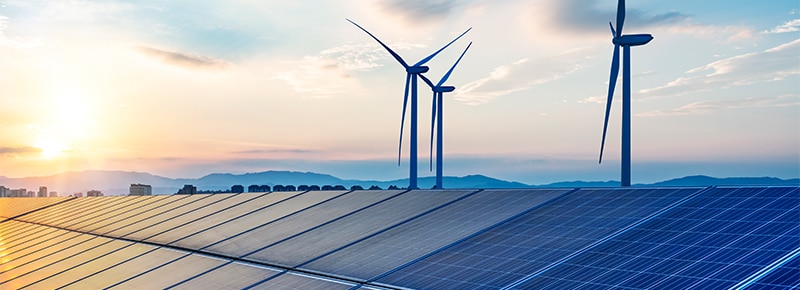Contents
Top
Energy Efficiency
Level VII efficiency standards
Energy Harvesting and Solar Power
Solar Power
Solar Cells
Microgrids and Battery Energy Storage Solutions
Microgrid
Battery Energy Storage Solutions
Sustainability and Energy Harvesting
Sustainability from an electronics perspective includes generating and using electricity in a way that minimizes ecological impact. There is a steady drive for more efficient usage of power and reducing harmful chemicals in electronics.
Energy Harvesting is a process of capturing energy from the environment and turning it into electricity. For example, power can be harvested from solar, thermal, and wind.
Energy Efficiency
Have you ever touched a laptop power supply and noticed it was warm to the touch? Have you noticed that newer power supplies emit less heat? These are examples of Energy efficiency in action.
Energy efficiency measures how well input power is converted to the output stage. The amount of power lost between the input and output stage is often dissipated as heat. The output power dived by the input power measures the efficiency.
For example, if a power supply outputs of 800W but requires an input of 1000W that supply is has 200W of loss and said to be 80% efficient.
Ƞ=Pout/Pin = 800W/1000W = 80%
Why is energy efficiency important? View Answer
Energy efficiency has become one of the most important considerations for consumers, designers and even government officials. The reason so many different people care about higher efficiency is because it saves on operating costs, extends product lifespans, and prevents additional pollution from further power generation.
Level VII efficiency standards
Level VII efficiency standards for External Power Supplies (EPSs) align with global regulations, promising benefits that will come with some notable challenges. We'll explore some of the pros and cons of this new standard which will be published in the latter half of 2026.
Pros:
- Reduction in Energy Consumed - Level VII standards ensure EPSs operate at the highest efficiency that is practical with today's technology, drastically reducing waste energy. This efficiency translates into energy savings, with a potential to reduce energy consumed by over 50% in comparison to previous generations of EPS.
- Compliance with Global Regulations - Meeting Level VII standards aligns with the goals of international environmental regulations and will help facilitate smoother market entry and acceptance in regions with strict environmental policies.
- Increased Product Reliability - Because of the reduction in waste energy (primarily heat) high-efficiency EPSs often come with enhanced components. This can lead to increased reliability and longer product life.
Cons:
- Increased Manufacturing Costs - The technologies required in the production of Level VII EPSs often result in higher production costs. This can translate into a higher pricing for consumers.
- Stricter Testing and Certification Requirements - Level VII compliance will involve testing and certification processes. The test process normally takes some time, but due to the influx of new certifications and re-certification there may be additional delays.
- Complexity of Implementation - Manufacturers may have challenges in utilizing new technologies / topologies while ensuring all products meet Level VII standards.
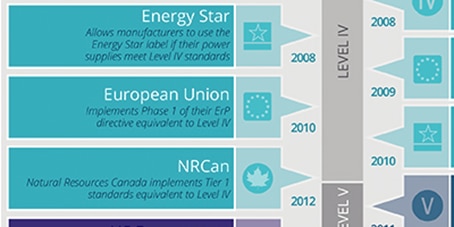
Energy Efficiency Standards for Power Supplies
Historically how legislation has evolved around energy efficiency standards
Energy Harvesting and Solar Power
Power does not have to come from an electrical grid with centralized power plants. Distributed power generation and energy harvesting have allowed electrical power to be generated much closer to the point of load.
Solar Power
Advancements in solar panel manufacturing have brought costs down significantly, allowing many businesses and homeowners to include solar power either as part of the mix of electrical sources powering locations or in some cases replacing traditional grid utility connections completely.
The electrical power coming from a solar panel is typically not ready to be directly wired into an electrical junction box. Solar panels produce direct current (DC) electrical power (like the DC power from a battery). Most household circuits use alternating current (AC) which changes voltage polarity many times a second. The use of power inverters can change DC to AC allowing for solar panels to power household circuits.
Other components often found in a solar installation:
What is maximum power point tracking (MPPT)? View Answer
Maximum power point tracking (MPPT) is a method for generating the maximum amount of electrical power that variable power sources such as wind turbines or solar panels can generate over time as conditions and electrical load change. Solar panels output power can be graphed as a power curve made up of the output voltage and current. The maximum power point is where the maximum electrical power can be generated found by the equation by P = V * I. Using a microcontroller to monitor voltage and current MPPT controllers can maximize the output of solar panels installations.
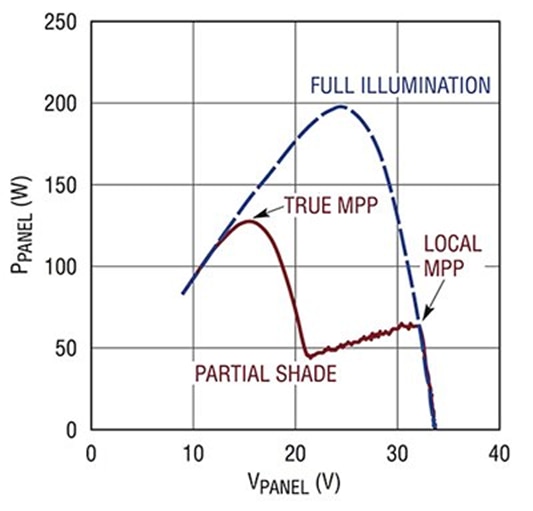 Picture showing the variability of maximum power based on how sunny / cloudy it is outside:
Picture showing the variability of maximum power based on how sunny / cloudy it is outside:https://www.digikey.com/en/articles/coping-with-power-variability-in-energy-harvesting
Solar Cells
Not all solar panels are made from the same materials. While it is true that solar cells can convert sunlight into electrical power, the exact construction methods and materials used can be radically different. Here is a small list of the few most popular:
- Monocrystal - solar cells made from one contiguous silicon structure / wafer. Due to using a single silicon portion for each cell, the overall efficiency for the panel is quite high up to 26% but the manufacturing costs are also higher due to processing.
- Polycrystal - cells are made up of many different silicon structures that have been melted together and allowed to cool, forming random crystal arrangements. This cheaper and easier construction method allows for a cheaper price for the finished panel, but the many different crystal boundaries create imperfections in the cell and are less efficient, usually 15 ~ 20%. Polycrystal silicon based solar panels are the most popular type of solar panels on the market.
- Thin film - also called amorphous solar panels are made by layering thin layers of photovoltaic materials such as amorphous silicon, cadmium telluride, or gallium arsenide. Without the need for solid silicon crystals in their construction, thin film solar panels are much thinner and can even be placed on flexible plastic backing. The simple construction and low cost of thin film solar cells have allowed them to spread from the consumer market to rooftop installations and even to the electrical grid. Depending on the exact materials used, thin film cell efficiency can range from 6 ~ 15% (but may increase with further research and development).
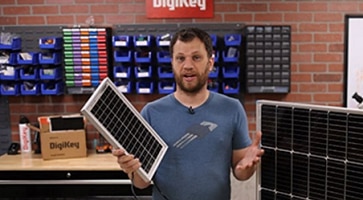
How To Build an MPPT Solar Charge Controller
Powering your electronics project using a solar panel can be fun, but how do you know if you're extracting and utilizing all the power a panel can provide? I built a maximum power point tracking solar charge controller to make sure I could extract all the power available from my solar panel.
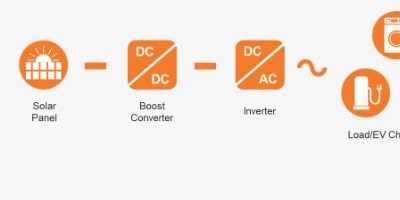
Solar Inverter
Renewable energy such as solar and wind power is one of the most efficient way to lower carbon emissions. The core of solar inverter is the high-power conversion stages, DC-DC boost converter and DC-AC inverter.
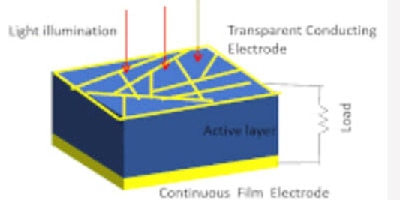
Harvesting the Sun With Silicon: Photovoltaic Cells
After talking about PIN junctions and photodiodes, it's important to give a nod to the most popular and revolutionary technology coming from it: Photovoltaic Cells-- most commonly known as the material in solar panels!
Microgrids and Battery Energy Storage Solutions
Microgrid
A microgrid is an electrical power grid that operates over a limited area with both the electrical power source and the electrical loads controlled by the same system. Unlike the larger primary electrical grid used by utilities companies microgrids typically only cover a few buildings and have a capacity in the kilowatts. These smaller electrical systems can either be separate from the primary electrical grid with no way to connect to the larger network or have a connection point allowing them to form electrical connections to the primary grid.
A smart grid is the idea that both power generation and power use can be carefully tracked and measured with two-way communication between smart digital devices. The benefit of a smart grid is that it would allow a much greater flexibly of power generation from renewable sources and the ability of a power network to identify power faults and rework and repair the network to ensure that grid stability prevents blackouts before they happen.
Battery Energy Storage Solutions
To provide a consistent power supply and to save costs when electrical supply is plentiful more electrical utilities are considering and planning to install Battery Energy Storage (BES). These installations are large scale batteries connected to the electrical grid. They provide power / discharge during during times of high demand and charge when power demand is low. As these are effectively large UPSs (uninterrupted power supplies), the battery management systems and electrical isolation technology is the same but a much larger scale.
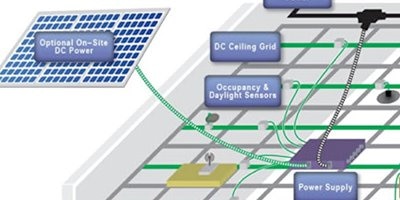
Can DC Microgrids Help Ensure Stable and Efficient Smart Energy?
Local power generation – whether connected to the main grid or islanded - has become practical and economically viable as technological advances have brought small photovoltaic arrays and wind turbines within the financial reach of businesses, small farms, and some homeowners.
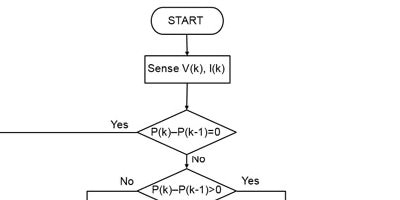
Power Management Tips for Energy Harvesting Systems
Designing a power management system for a source that harvests energy from the environment can be challenging. These sources, from solar cells to vibrational energy, and even power from thermal differences, are all small amounts of power that vary unpredictably.
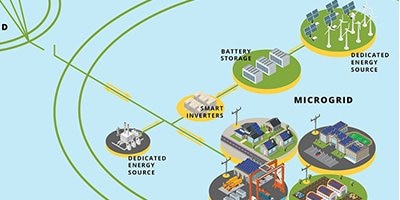
Using Electrification and Automation to Create More Efficient and Sustainable Power Grids – Part One of Two
Electrified systems, plus the use of automation that ties them all together and supports smart grids and microgrids, are important factors moving society toward a more sustainable and greener future.






